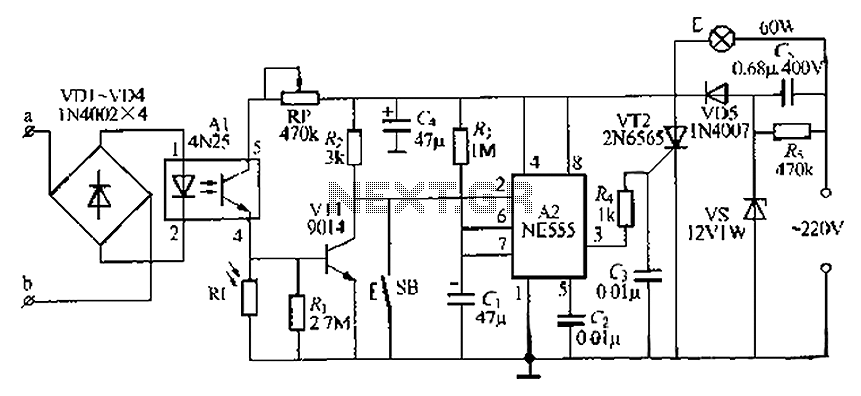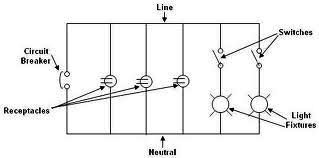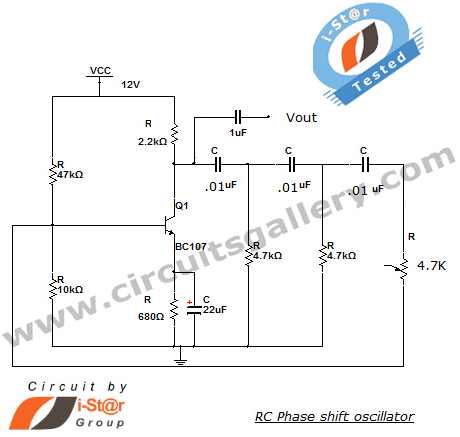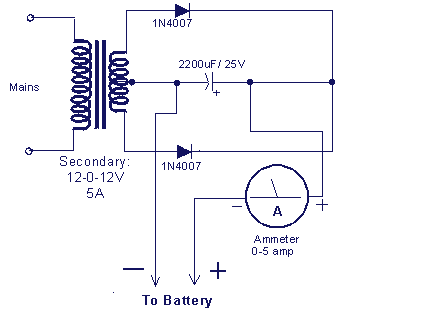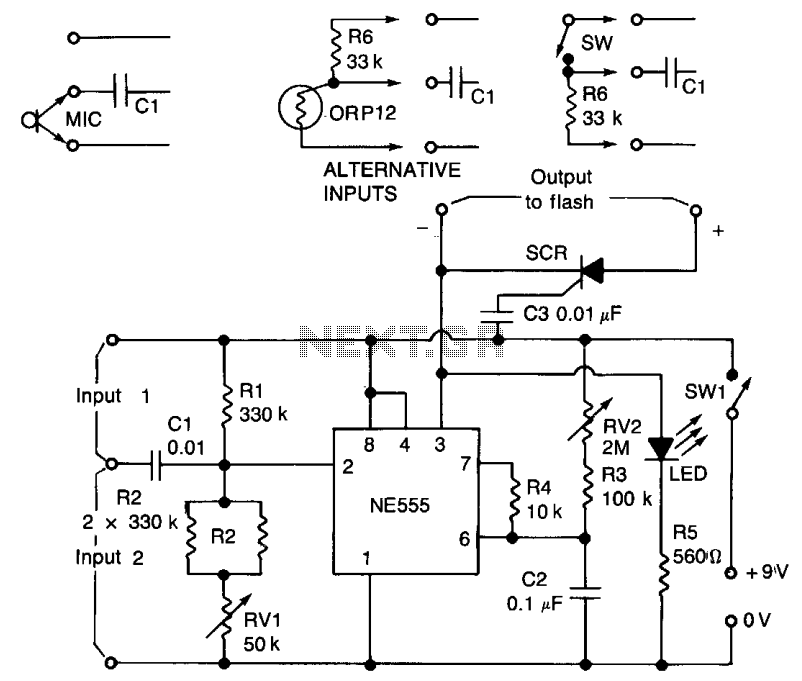
Universal electronic timer circuit diagram
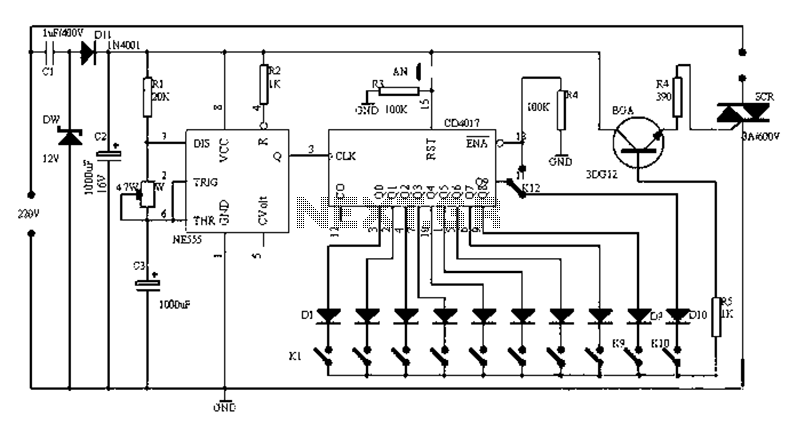
Figure 1-1 illustrates a general-purpose timer capable of timing intervals ranging from 5 minutes to 18 hours. The timing cycle can be adjusted to span from 5 minutes to 20 hours, with a maximum control time of 18 hours. The power control is rated at 500W or less, with circuit power consumption maintained below 1W. The time base circuit utilizes an NE555 timer and capacitor C3, while resistors R1 and R2 form the pulse generation circuit. The pulse period can be adjusted between 5 minutes to 2 hours, with R2 extending the pulse period of operation. The maximum duration without a pulse is 1 hour when R2 is at its longest setting. Additionally, a CD4017 counter and diodes D2-D10, along with relays K1-K10, function as a delay multiplier circuit. This arrangement allows for a total pulse period extension of up to 10 times. The K1-K10 relays control the multiplication factor, and the NE555 output pulse period is represented on a logarithmic scale. The BG and TRIAC control circuit manage the AC power. When the BG group is activated, the SCR is triggered into conduction, thereby controlling the circuit. When the BG base is reduced to a very low level, the SCR turns off, halting the operation of the controlled circuit. Components C1, DW, D11, and C2 form a simple DC supply circuit, providing 12V DC power for the timing circuit. During operation, when K12 is set to 1, K1 opens, and after 10 pulses from the NE555, the CD4017's enable (EN) pin goes high, stopping the count. By pressing the AN switch, the CD4017 can be reset to count again, allowing timing up to 18 hours. When the timing cycle is initiated, K12 can be set to 2, enabling the CD4017 to cycle through counts, with a maximum loop duration of 20 hours. The timing of opening and closing operations is controlled by relays K1-K10.
The described circuit functions as a flexible timer, suitable for various applications requiring precise timing control. The NE555 timer is a widely used integrated circuit that can generate accurate timing pulses, making it ideal for this application. The use of the CD4017 decade counter allows for easy extension of timing intervals by counting pulses generated by the NE555. The combination of resistors R1 and R2 provides the ability to fine-tune the timing period, while the capacitive element C3 ensures stability in the timing operation.
The circuit's AC control is facilitated by the TRIAC, which allows for switching high power loads safely. The BG control mechanism ensures that the TRIAC is only activated when necessary, conserving energy and prolonging the lifespan of the components. The inclusion of a simple DC power supply circuit ensures that the timer operates reliably with a stable voltage source.
The design is modular, allowing for easy adjustments and expansions. The use of relays for the timing control provides a robust solution for managing different timing cycles, further enhancing the versatility of the timer. Overall, this circuit represents a practical solution for applications requiring a reliable and adjustable timer, capable of managing both short and extended timing intervals efficiently.Figure 1-1 The general-purpose timer once timing of 5 minutes to 18 hours; the timing cycle from 5 minutes to 20 hours; the total time of the timing and the timing to open and close 18 hours. Controlling power of 500W or less, the circuit power consumption is less than 1W. Time base circuit NE555 and C3, W, when R1, R2 constituting the base pulse generating circuit. W can adjust the pulse period from 5 minutes to 2 hours between changes. R2 extended from the pulse period of action. R2 is the longest period without a pulse for 1 hour. CD4017 counter and D2-D10, K1-K10 delay multiplier circuit and other components. The circuit will extend a total of 10 times the pulse period. K1-K10 control multiplication factor, and the NE555 output pulse period was logarithmic plot. BG and triac control circuit constituting the AC power. BG group high level conduction, SCR is triggered conduction, controlled circuit. BG base to very low cut-off, SCR is turned off, the controlled circuit to stop working. C1, DW, D11, C2 composed of simple DC supply circuit to provide 12V DC power for the timing circuit. When a timer, K12 set to 1 at the, K1 open. NE555 pulse output 10 after, CD4017s EN is high and stop counting. Then click the AN, CD4017 counted once again, once the timing up to 18 hours. When the timing cycle, K12 put 2, CD4017 cycle count. Each time through the loop the longest 20 hours. Timing of opening and closed by a timing control K1-K10.
The described circuit functions as a flexible timer, suitable for various applications requiring precise timing control. The NE555 timer is a widely used integrated circuit that can generate accurate timing pulses, making it ideal for this application. The use of the CD4017 decade counter allows for easy extension of timing intervals by counting pulses generated by the NE555. The combination of resistors R1 and R2 provides the ability to fine-tune the timing period, while the capacitive element C3 ensures stability in the timing operation.
The circuit's AC control is facilitated by the TRIAC, which allows for switching high power loads safely. The BG control mechanism ensures that the TRIAC is only activated when necessary, conserving energy and prolonging the lifespan of the components. The inclusion of a simple DC power supply circuit ensures that the timer operates reliably with a stable voltage source.
The design is modular, allowing for easy adjustments and expansions. The use of relays for the timing control provides a robust solution for managing different timing cycles, further enhancing the versatility of the timer. Overall, this circuit represents a practical solution for applications requiring a reliable and adjustable timer, capable of managing both short and extended timing intervals efficiently.Figure 1-1 The general-purpose timer once timing of 5 minutes to 18 hours; the timing cycle from 5 minutes to 20 hours; the total time of the timing and the timing to open and close 18 hours. Controlling power of 500W or less, the circuit power consumption is less than 1W. Time base circuit NE555 and C3, W, when R1, R2 constituting the base pulse generating circuit. W can adjust the pulse period from 5 minutes to 2 hours between changes. R2 extended from the pulse period of action. R2 is the longest period without a pulse for 1 hour. CD4017 counter and D2-D10, K1-K10 delay multiplier circuit and other components. The circuit will extend a total of 10 times the pulse period. K1-K10 control multiplication factor, and the NE555 output pulse period was logarithmic plot. BG and triac control circuit constituting the AC power. BG group high level conduction, SCR is triggered conduction, controlled circuit. BG base to very low cut-off, SCR is turned off, the controlled circuit to stop working. C1, DW, D11, C2 composed of simple DC supply circuit to provide 12V DC power for the timing circuit. When a timer, K12 set to 1 at the, K1 open. NE555 pulse output 10 after, CD4017s EN is high and stop counting. Then click the AN, CD4017 counted once again, once the timing up to 18 hours. When the timing cycle, K12 put 2, CD4017 cycle count. Each time through the loop the longest 20 hours. Timing of opening and closed by a timing control K1-K10.
